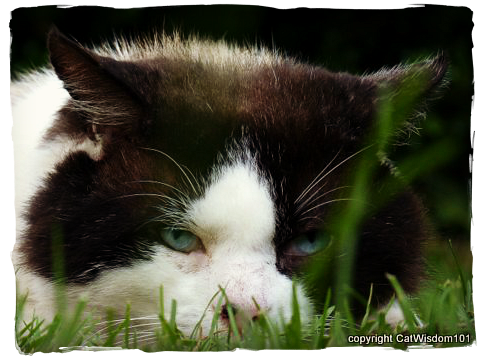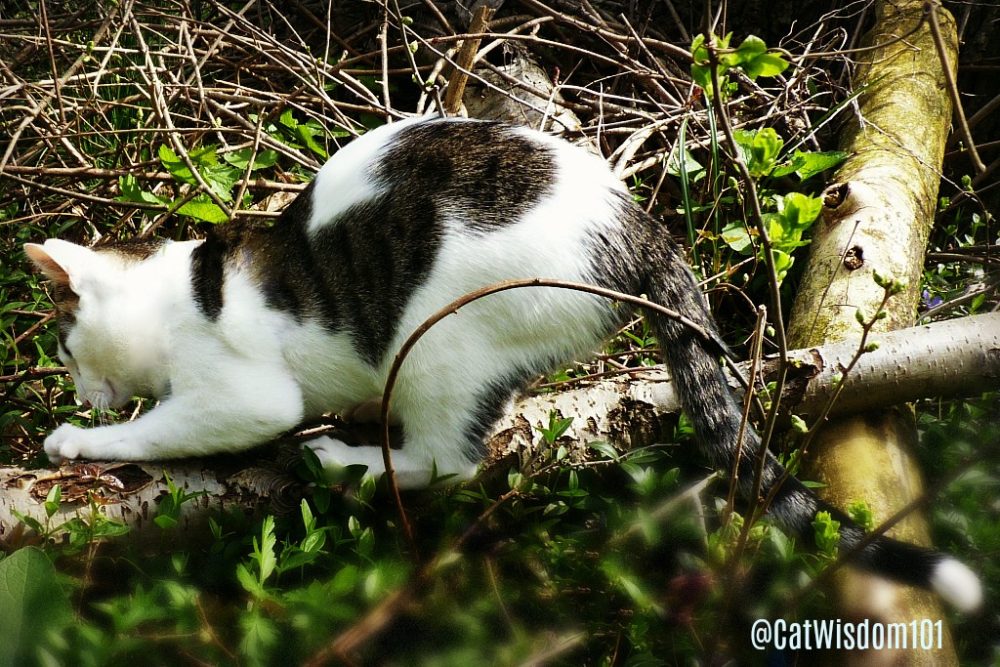Cat Care at the Tail End Of Life

No one wants to think about their cat lingering over a long illness and dying, but palliative care is about making the tail end of a cat’s life comfortable and humane. Our guest Vet 101 post today is with veterinarian Dr. Letrisa Miller. This topic is close to the bone. We spent 2 long and sleepless years tending to Merlin in palliative care. There are extensive posts about him, CKD and many posts about elderly cat wisdom by him under the category Mondays With Merlin. Less than a year after he died, we found ourselves deep in palliative care with our Clyde, now 19. It’s exhausting and burnout is real. There is no right answer to what extent a person can or should do for their cat. It’s personal and hopefully the decision is from the heart.
Feline Palliative Care by Dr. Letrisa Miller
Recently, I have been thinking about the incredible devotion and effort of people outside veterinary offices who care for seriously ill cats. A cat with a major chronic illness, particularly if the illness is terminal, often requires palliative care (that is, care that focuses on the relief of symptoms and on making the patient comfortable). With geriatric patients and cancer patients, whose care is sometimes highly complicated, this type of care can place incredible demands on the caregiver. In addition to the long days and long nights spent caring for their invalid cat, caregivers may face financial and emotional stresses.
In some cases, the stress of caring for a loved pet leads to “caregiver burnout.” The symptoms are similar to depression and are easily overlooked when one is putting all his or her effort into caring for a patient. Add to this the financial strains associated with the care of an ill pet, and you can have a recipe for serious family trouble.
Help is available, though. If you are feeling tired and alone, if you think you or someone you know might be experiencing caregiver burnout, an Internet search will lead you to sites that may be of help. Much of the information about caregiver burnout is written for caregivers of humans, but the same principles apply: Don’t forget to take care of yourself and your family if you are caring for a sick cat, and don’t let insensitive coworkers or friends who voice opinions like “It’s just a cat” get you down.
I experienced this stress myself when my cat Oedipus started to suffer from progressive paralysis of his hind limbs. First he had trouble walking, then he became incontinent, and soon after that he stopped eating.
Over the course of Oed’s illness my husband and I kept asking ourselves whether he was in pain. How much should we put him through in an attempt to get a diagnosis? Will getting a diagnosis make any difference in treatment? Should we euthanize him? How much can we afford? What does he want? None of these questions had easy answers. In the end we decided to do some diagnostics, but we balked at highly invasive procedures. We did get a diagnosis, however: spinal lymphoma.
The diagnosis led to another round of difficult questions: Do we put Oed through chemotherapy? If so, for how long and how aggressively? How do we decide when to let him go?
We decided to try chemotherapy. This meant also putting a feeding tube into his esophagus so he wouldn’t starve himself to death while being treated. Thus began the thrice-daily ritual of warming food, adding medications, loading the food into a giant syringe, and putting it through the feeding tube into my poor Oed. Every day we would also find and clean up the spots of carpet where he had leaked urine, and I’d give Oed baths to clean the fur and skin soiled by his having lain in that urine.
We tried for about a month but he did not improve, and we finally made the decision to euthanize him. Reaching this decision was agonizing and filled with guilt. Had we waited too long? Or not long enough for him to respond to treatment? I still don’t have answers for these questions.
My experience with Oed gave me a deeper appreciation of what my clients take on at home with their ill pets. I am fortunate to have a husband who was exceptionally supportive during this time. He never got upset about the urine all over the house, the expense of the treatment and care, or the time he didn’t get to spend with me because I had to care for Oed.
Unfortunately, many either don’t have such a good support network or the network begins to crack and fall apart because care goes on for so long. When your support network begins to falter, caregiver burnout really becomes a danger. Don’t forget to take care of your relationships and yourself while you take care of your ailing cat!
One of the questions I most frequently confront as a doctor directing palliative care is, “How do I know when it is time to let them go?” This question is especially difficult for the veterinarian to answer because we usually don’t see the cat on a daily basis, so we don’t know how many good days and how many bad days the patient is having. Cats also like to put on a show of feeling well when they come to see the vet, which makes our job—recognizing whether your cat is depressed or painful—even more difficult.
What I try to do is to help people look objectively at their cat’s quality of life. I ask them to make a list of the things their cat has always liked to do and to then look at this quality-of-life list once a week and check off the things the cat is still willing and able to do. The list is important because gradual changes are easily overlooked.
When the number of checked items grows small or when certain key activities are no longer possible, this probably indicates that the cat’s quality of life has declined to a point at which euthanasia (if it is an option) ought to be considered.
Just as important as making the quality-of-life list is deciding ahead of time on a threshold at which you will consider euthanasia. For example, you might want to consider euthanasia when your cat is no longer willing or able to do less than half of the items on the list. In place of a percentage, you could also single out two or three key activities as a threshold. Having a threshold can help prevent later feelings of guilt that you waited too long (or did not wait long enough) before making the decision.
The quality-of-life list is also beneficial in helping you answer the question, “Is my cat in pain?” Often the only sign of pain in cats is a decrease in activity. If you notice that your cat is less active or no longer does once-favorite activities, discuss the possibility of pain with your veterinarian. He or she should be able to provide appropriate pain control for your cat.
Adequate pain control is imperative when palliative care is chosen. Fortunately, this can usually be achieved with opiates (morphine-like drugs). And, although the long-term use of opiates may lead to physical dependence (addiction) and is thus often inappropriate for patients with nonterminal illnesses, this is not a concern with terminal patients who have no reason to stop taking the drug.
If pain cannot be controlled, euthanasia should be strongly considered. Euthanasia is not mandatory at the end of a pet’s life, and the decision to choose euthanasia should always be made by the caretaker and not the veterinarian.
However, when pain cannot be controlled and palliative care is no longer effective, continuing that care is, in my view, far less merciful than allowing a beloved pet the release of death. In all other circumstances, the veterinarian’s job is to support both the cat and the caregiver.
Providing palliative care to a furry family member can raise issues of guilt. The financial and time burdens can be considerable and sometimes cause hardship in a family. Because most caregivers don’t have experience providing palliative care, they often experience feelings of inadequacy. For this reason you need to have a good veterinary team, one willing to help you through the experience.
Find a team that cares enough to spend time with you explaining what to expect and how to do all of the care. You should receive written instructions on giving medications and feeding. From day to day the doctor will probably not be the one to hold your hand, but a well-trained technician or assistant should be available to answer your many questions. Any questions that they can’t answer, they should pass on to the veterinarian. You should expect frequent check-ins with the doctor and/or her or his staff.
The veterinary team won’t be able to answer the big questions such as how much you can spend or when or if you should choose euthanasia, but they should be there to help support you. Only you and your family will be able to answer the personal questions of financial means and when or if the time to consider euthanasia has arrived. The veterinary team might be able to offer a shoulder to cry on, and they might be able to share experiences that can help guide you, but answers to the big questions must be your own.
Palliative care is a big burden to take on, and it can be both financially and emotionally draining. But with the right support team and with an awareness that you also need to take time to care for yourself, you will make it through and, I hope, be able to take some comfort in the knowledge that you were able to give your cat a wonderful gift in his or her moment of greatest need.
Letrisa Miller DVM is a feline specialist in private practice at Connecticut Feline Medicine and Surgery in Manchester, Connecticut. Her Website is CFMS




19 Comments
Oliver
Palliative Care also belongs to the elderly. do not hesitate giving it to your old people as well.
Michael
Attracting 1,000 people annually, Spring Fling is an exquisite garden party that supports Big Bend Hospice, the region’s leader in hospice care for 35 years. Tickets are available now for Spring Fling: Under the Artists’ Moon on May 17 at Tallahassee Nurseries. Visit BigBendHospice.org or call
tracy
going through this right now. It’s horrible.
Peggy Ballinger
If the guidelines are the same for humans as they are for pets, then why is euthanasia illegal in most states for humans? I strongly disagree on euthanizing elderly animals! You call euthanasia humane! I call it cruel and the easy way out for lazy humans!
And you’re a vet for God sake!
I’ve had several cats in my lifetime, most of them strays given up by irresponsible human beings. I hate to hear people call themselves animal lovers and they don’t have a problem euthanizing their animals when they’re elderly and become a burden to them. Go ahead! Send your pathetic human comments! You should all feel guilty if you euthanized your pet due to old age!
visit the official website
Κeep on writing, great job!
Hегe is mу blog ρost … visit the official website
Vet Net Jobs
We look forward to you lisitng your jobs on vet network, we hope that this information was useful to you and that you get a large amount of applications to your positions.
Colehaus Cats
Thank you for this article. Insightful and important, especially on the topic of guilt. We’ve been down a similar road a dozen times now. We’ve learned how different each kitty’s needs become and have learned to tune in on when the time is right. Even so, it never gets any easier.
Mary Matthews
When my first cat went into kidney failure, I wish I’d thought of a quality of life list! I sometimes worry that I may have kept her alive longer than she wanted.
Mandy
Thanks for the interesting article. It is always upsetting to think about our beloved kitties growing up and getting older and older, with declining health, but it is definitely important to be well-informed rather than blissfully ignorant and disregarding the ways your cat may feel and problems they may face as they age.
meowmeowmans
Thank you for such a thoughtful and informative post. We’ve been through the process a few times, and it’s never easy.
Oui Oui
I’ve been through this a few times with cats suffering from strokes, uncontrollable diabetes (it may be easier these days), leukemia, cancer and acute kidney disease. Its never easy, but my rule of thumb is, if its not going to get better and the cat is getting worse, and they are in pain then its time is close, and when that decision is made, try not to beat yourself up over it. The most important thing is you’ve shared your love and home with it, and so many deserving animals never get that chance. Then go out and love again.
Abby
A very information and thought provoking posting.
Unfortunately for all of us, it is a guessing game, and all you can do is the best you can.
purrs
>^,,^<
♥Abby♥Boo♥Ping♥Jinx♥Grace♥
Brian
That really was a great and thoughtful post. These decisions are alwaysnso difficult and confusing.
Deb
Absolutely brilliant post. I’ve had to make this decision 3 times. It’s one of the most gut wrenching decisions I’ve ever had to make. I have been fortunate that the vet and assistants with whom I have had a relationship going back to the first cat some 26 years ago, have been the best people caring people I could want. From understanding the need for private time to say, “Goodbye” as well as someone to hold me while I cry and a follow-up call to see how I’m doing they have been just wonderful. One of their staff even found my next two cats after I let the last of the original bunch go over the Rainbow Bridge.
Patty
Just had an E-Tube placed in my otherwise-healthy & active 14-yr old Javanese following acute pancreatitis attack with no resumption of eating. Vet specialists now working on his nausea before sending him home. He had mild chronic pancreatitis for a while but eventually became anorexic, started on prednisone, began eating, but then suddenly crashed. Wish I could read HIS mind on where he would draw the line. Don’t want it to be only about what I want.
Jane
Thank you for a thoughtful post on a painful subject that most cat lovers have agonized over.
Bernadette
What a wonderful article, very detailed and full of information. I’ve given palliative care plenty of times, usually for just a few weeks or months, but also for a year or more. When it’s done, I don’t know how I did it, but having given the care always eases the idea that I didn’t do enough.
boomermuse
B, guilt is the biggest caregiver issue, not knowing if we do too little or too much. Either way, it’s a stressful time as you know and I about our situation with Merlin.
Katie Isabella
I went through that with my Tortie. It is a hard hard hard road to travel both for the pet and for the pet parent.